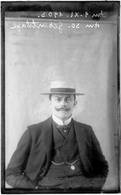Physician, physical anthropologist, ethnologist. Born in Radowitz (Posen, then Germany, now Poland) 9 November 1872, died in Berlin (Germany) 4 April 1938. Lehmann-Nitsche studied anthropology and medicine at Freiburg im Breisgau, Berlin and Munich. He gained doctorates of philosophy and medicine at Munich in 1894 and 1897 respectively. In 1898, his anthropological dissertation on the long bones of the southern Bavarian “Reihengräber” population was awarded the Goddard Prize by the French Anthropological Society.
His later studies on the fossil men of the pampas would be awarded the Broca Prize from the University of Paris in 1910. In 1897, Francisco Moreno, the founder of the Museo de la Plata, sent for Lehmann-Nitsche to serve as director of the anthropology department and curator of ethnography and archaeology at this major Argentinian museum in Buenos Aires. By 1905, he had also become employed at the University of Buenos Aires, and in 1906 received the first professorial chair in physical anthropology set up in South America at the La Plata University. He remained in Argentina until his retirement in 1929, returning thereafter to Germany.
While at the beginning of his scientific career his major areas of specialization were physical anthropology, medicine and prehistory, he became increasingly interested in other fields, including the material culture of the original inhabitants of Argentina, folklore, Indian languages, mythology, astronomy, paleontology, ethnography, archaeology, ethnozoology and ethnobotany. His publication record of some three hundred and seventy five titles illustrates this impressive breadth of interest. Lehmann-Nitsche was also interested in the popular circulation of his ideas and contributed much to the exchange of information between Argentinian and German researchers. He gathered materials for his publications not only from literary sources but also directly during field trips in Argentina. In 1900 he undertook his first trip into Southern Argentina to the Chaco as far as Jujuy, collecting myths and legends in the native languages. The majority of this material was published, with extensive annotations and bibliographies supplied, while a portion remains in the Ibero-amerikanisches Institut in Berlin awaiting scientific interpretation. An example of the latter is the three-volume manuscript of Textos Araucanos. The Ibero-amerikanisches Institut also possesses his “Biblioteca Criolla”, a collection of articles and pamphlets on the Argentinian Gauchos.
(text written by Frauke Riese, by courtesy of Berthold Riese; photo source: http://portal.iai.spk-berlin.de/Robert-Lehmann-Nitsche.104.0.html)



